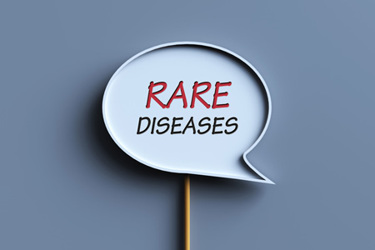Hope For People With Spinocerebellar Ataxia
By Melissa Beiner, M.D., Senior Director of R&D, Biohaven Pharmaceuticals

“Sometimes I feel like I’m living in a physical prison that deteriorates your ability to have others understand you,” said one patient with a form of ataxia called spinocerebellar ataxia (SCA). Over my career, I’ve heard several variations of such statements from people with SCA – a devastating disease with a huge physical and psychological burden and no treatment or cure. SCA is just one of the many rare diseases that affect approximately 25 - 30 million people in the United States. And what is surprising is that despite there being 1 in 10 people living in the U.S. with rare diseases, over 95% of these disorders do not have a single FDA-approved treatment.
Rare diseases are called that for a reason. The small patient population, coupled with difficulties in diagnosis, challenges associated with research in the rare disease space, and the limited resources directed toward finding meaningful therapies, often leave patients with limited clinical trial options and no treatment options.
Case in point: SCA.
Decoding Spinocerebellar Ataxia
SCA is a relentlessly progressive, debilitating, and fatal neurodegenerative disease caused by damage to the cerebellum, brainstem, and spinal cord. It is an autosomal dominant disease, meaning there is a 50% chance of someone with SCA passing it on to their children. SCA affects approximately 15,000 people in the U.S. There are more than 40 distinct SCA genotypes, with SCA1, SCA2, SCA3, and SCA6 being the most common.
Imbalance in gait, slurred speech, and difficulty with fine motor skills are hallmark symptoms of ataxia. These core features of the disorder typically resemble inebriation. Patients can also have issues with vision and eye movements, difficulty swallowing, and impairment in cognition and affect. Imagine in your routine daily life gradually losing the ability to walk and suffering from frequent falls that result in injuries, not being able to dress or feed yourself, or not being able to effectively communicate. That is the devastating impact of SCA.
Eventually falls become a significant cause of morbidity and even mortality in people with SCA and, as their gait gets worse, people begin to use wheelchairs. One patient with SCA3 said, “If I was not so fearful of falls (and the potential damage that the fall may inflict on me), this could open up a steadily closing door in my activities.”
People with SCA usually die prematurely, approximately 10-20 years from the onset of symptoms. And the patient burden goes well beyond the physical symptoms of the disease.
The Overwhelming Burden of SCA
Communication is a major challenge for many people with SCA. The disease causes slurred speech that worsens over time, making it difficult for people to communicate. The emotional and psychological burden and the impact this has on patients’ and caregivers’ quality of life cannot be overstated. In fact, depression, anxiety, and even suicidality are common in patients with SCA.1
A study done to understand the burden of SCA on quality of life of patients revealed that the physical burden of the disease often translates into a low quality of life for patients and caregivers. In the study, of a possible 8,000 points denoting burden, almost half of the interview participants gave the highest scores to issues regarding gross motor function (42.2% of points), followed by speech (13.9% of points), and independent living (12.3% of points). Specifically, for gross motor function, participants gave the highest scores to impaired mobility (46.6% of points), loss of enjoyable activities (9% of points), and lack of balance (25.8% of points). In a follow-up after a year, over three-quarters of patients reported falling and an increased reliance on others, as well as changes in their daily routines as a result of these falls.2
There is also an added socio-economic cost associated with this disease. A study in Spain evaluating the costs associated with SCA demonstrated that the most significant categories of cost include informal care, early retirement (permanent disability), medications, and orthopedic devices. There is also an indirect cost to the caregivers in terms of the time spent caring for family members with SCA.3
Understanding the Disease Driver
Glutamate, the most abundant excitatory neurotransmitter in the brain, plays a key role in SCA. Research has shown that glutamate dysfunction is implicated in the pathophysiology of SCA. Release of glutamate is necessary for the normal function of neurons, but the levels of this neurotransmitter must be tightly regulated to avoid toxic effects on the neurons. Altered levels of glutamate in a given region of the brain can have a profound effect on neurologic function. In SCA, it has been shown that glutamate dysregulation in the cerebellum leads to neuronal cell death and, ultimately, atrophy of the cerebellum and brainstem.
Our clinical development program for SCA has been based on the knowledge that the regulation of glutamate can go a long way in slowing down the progression of this severely debilitating disease.
Troriluzole and Our Clinical Studies
At Biohaven, we first started exploring troriluzole over eight years ago. Troriluzole is a prodrug of riluzole, which was originally approved for ALS but has been limited by inconsistent drug exposures, dose-dependent increases in liver function tests, poor solubility, and a negative food effect that lowers drug levels. Designed to improve upon the known neuroprotective properties of riluzole and optimize the pharmacokinetic attributes that have limited its broader use, troriluzole allows for higher drug exposures, improved bioavailability, optimized safety profile, convenient once daily dosing and does not require fasting when dosing. We discovered that troriluzole has the potential to significantly impact the lives of people living with SCA.
Troriluzole is a glutamate modulator, a third-generation novel prodrug that metabolizes inside the body and is designed to provide increased absorption and pharmacological activity in the treatment of disease. It has a well-described mechanism of action and biologically plausible action to protect neurons from glutamate dysfunction, a key factor for patients living with SCA.
Biohaven's troriluzole clinical development program in SCA collected data over an eight-year period, including a robust long-term safety profile. We designed and implemented three studies in collaboration with leading SCA experts in the United States and Europe. Across three studies, the data suggest that SCA patients treated with troriluzole show consistent slowing of disease progression compared to untreated patients from an external control arm collected by the largest SCA natural history cohort. Certain rare diseases, such as SCA, have a well-defined natural history and the disease is not known to remit without treatment. The National Ataxia Foundation and leading SCA experts along with the patients who participated in the natural history study spent considerable efforts to study the disease course of SCA. These efforts formed the foundation for the natural history data that served as a third-party, objective external control comparison to assess the efficacy of troriluzole.
Hope for the Future
It has been more than thirty years since the first specific genetic mutation was discovered for SCA but until now, patients living with SCA had no hope for a potential treatment option to slow disease progression. Current treatment approaches for SCA focus on palliative care and symptom management. There are still no approved treatments for SCA and the unmet need in this patient population remains high.
Biohaven has filed a New Drug Application (NDA) with the FDA for troriluzole that was accepted under priority review but a decision on our application has been delayed. We encourage the SCA community to join in advocating for the FDA to utilize the regulatory flexibility afforded by congressional mandates and within FDA guidance in order to effect a meaningful difference in the lives of patients and their families affected by rare and life-threatening diseases. The National Ataxia Foundation has launched a petition on Change.org urging the FDA to prioritize reviews for treatment options for rare diseases with urgent unmet needs, including SCA. You can view and sign the petition here.
Researching rare diseases has its challenges and complexities but following rigorous science will always advance a field. It has been a long road to reach this moment in time, but we are motivated by the SCA patients who have inspired and motivated the team at Biohaven to continue forward momentum for troriluzole. We understand that for people living with SCA each day matters, and a first-ever treatment is urgently needed.
About the Author
 Dr. Beiner was formerly a board certified, practicing pediatrician prior to joining Biohaven in 2017. Dr. Beiner conducted pre-clinical research in neuroscience, focusing on spinal cord injury and neuronal regeneration both at the Yale School of Medicine Neurosurgical Research Laboratories and at The Miami Project to Cure Paralysis. In her current role at Biohaven, Dr. Beiner is the Director of Research and Development and is the program lead for the spinocerebellar ataxia (SCA) program. Dr. Beiner also leads a clinical study in trigeminal neuralgia and supports the OCD program.
Dr. Beiner was formerly a board certified, practicing pediatrician prior to joining Biohaven in 2017. Dr. Beiner conducted pre-clinical research in neuroscience, focusing on spinal cord injury and neuronal regeneration both at the Yale School of Medicine Neurosurgical Research Laboratories and at The Miami Project to Cure Paralysis. In her current role at Biohaven, Dr. Beiner is the Director of Research and Development and is the program lead for the spinocerebellar ataxia (SCA) program. Dr. Beiner also leads a clinical study in trigeminal neuralgia and supports the OCD program.
A graduate of Yale University School of Medicine, Dr. Beiner completed her internship and residency in Pediatrics at the Yale New Haven Children’s Hospital.
References
- National Library of Medicine. Depression and Clinical Progression in Spinocerebellar Ataxias. Available at https://pmc.ncbi.nlm.nih.gov/ articles/PMC4695274/. Accessed May 21, 2025.
- Seeberger, L., Beiner, M. et. al. Understanding the Spectrum of SCA1. SCA2, SA3, and SCA6 through the Eyes of the Patient: Burden of Illness and Quality of Life. Presented at the World Congress of Neurology, 2023. Data on file, Biohaven. https://c6a2x5m8.delivery.rocketcdn.me/wp-content/uploads/TROSCAPostWCNLB3.0_FINAL.pdf
- López-Bastida J, Perestelo-Pérez L, Montón-Alvarez F, Serrano-Aguilar P. Social economic costs and health-related quality of life in patients with degenerative cerebellar ataxia in Spain. Mov Disord. 2008 Jan 30;23(2):212-7. doi:10.1002/mds.21798. PMID: 17999424. https://pubmed.ncbi.nlm.nih.gov/17999424/
